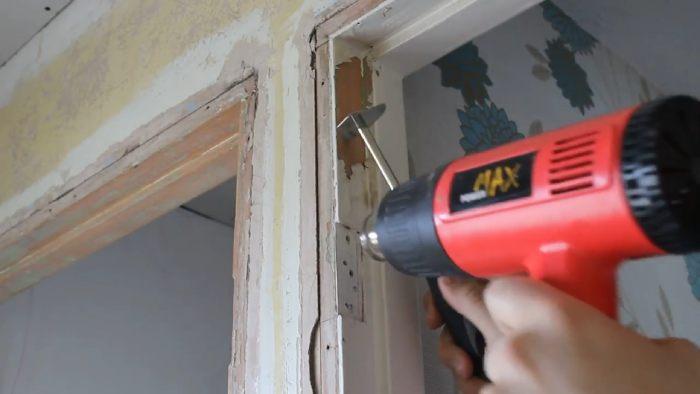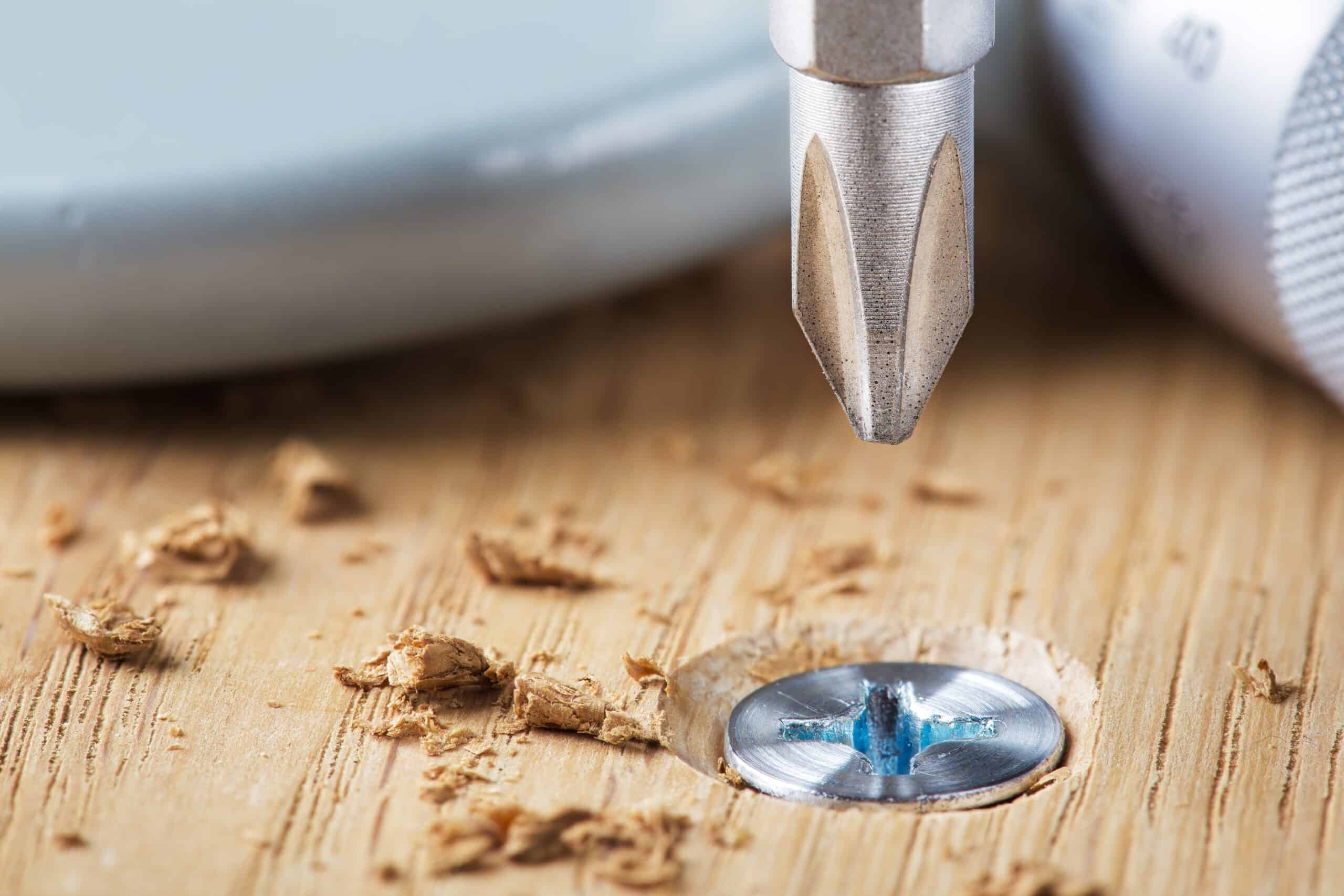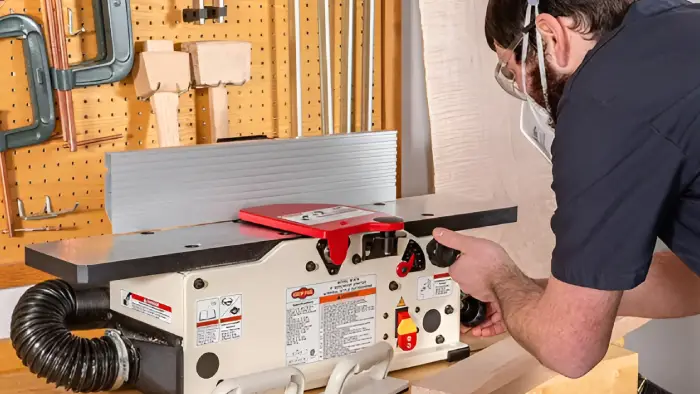WoodenuKnow.com is a participant in the Amazon Services LLC Associates Program, an affiliate advertising program designed to provide a means for sites to earn advertising fees by advertising and linking to Amazon.com and may earn from qualifying purchases.
If you’re looking to give your home a quick facelift, it’s time for a door frame makeover. Class up the joint with some fresh paint, but first, we have to figure out how to get rid of that old paint stuff.
There are easy and effective methods when it comes to removing paint from wooden frames, so say goodbye to outdated looks and hello to stylish transformation.
Sanding is one of the most common ways to get paint off wooden door frames. For those who don’t have access to sanders, using a commercial-grade solvent like a paint stripper may be your best option.
Applying the stripper and then scraping away with a plastic scraper can help get rid of any remaining bits of old paint.
Using a hot air gun is another option. Lastly, lacquer thinner and pressure washers can both provide an effective way to remove stubborn layers of thick paint from wood surfaces quickly and easily.
Let’s explore each method further so you can determine what could work best in your situation.
How to Remove Paint from Wooden Door Frames: Effective Methods
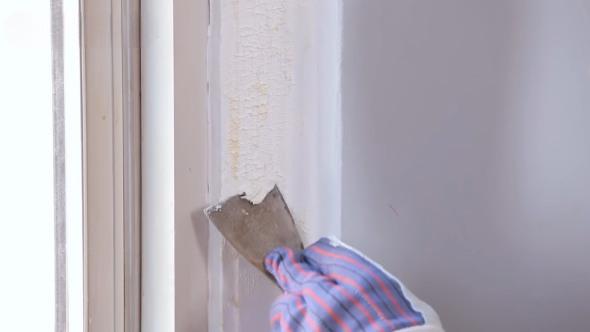
Before you get started on your DIY project, don’t forget to take safety into consideration. Equip yourself with protective gear such as gloves and goggles for any toxic fumes or irritants.
Now that’s sorted, here are the most effective techniques guaranteed to help strip paint from wood door frames, so make sure you check them out.
Method 1: Sanding
Sanding is your ticket to efficient paint removal from wooden door frames. Just follow these easy steps, and you’ll be on your way to a hassle-free job.
Step 1: Prepare the Surface
The first step in stripping paint off wooden door frames is to prepare the surface. This ensures that your sanding process runs smoothly and efficiently.
Lay down protective plastic floor sheeting on the floor around your work area to catch any particles that may occur during the sanding process. It’s also important to make sure all of your tools are clean and free of dirt or residue before starting.
Step 2: Start Sanding
Once you have prepared the surface and gathered all of your supplies, it’s time to start sanding. Begin by using a sanding block with 80-grit sandpaper to remove any existing paint layers from the interior door frame.
You may need more than one pass to get everything off if there are multiple layers of paint present on your frame.
For bigger jobs, it’s recommended to use a palm sander with 60-grit paper initially, then switch to 120-grit paper for a finer finish before wiping away any loose filth with a towel or cloth rag.
You’ll need to keep an eye out for any exposed wood as you’re sanding since this indicates that all of the paint has been removed from that area.
Step 3: Finishing Touches
Once you’ve completed all of your sandings and ensured that no paint remains on the frame, it’s time for some finishing touches. Start by using an abrasive pad and steel wool cleanser on any remaining rough spots or crevices where more stubborn patches of paint may remain hidden away.
Once complete, vacuum up any loosened dirt particles before continuing with vacuuming again after cleaning down the entire frame with mineral spirits and warm water.
Method 2: Use Paint Stripper

For quick and easy removal of paint on your wooden door frames, try using a paint stripper. It’s easy. Just follow the directions to see a brand-new look in no time.
Step 1: Collect the Necessary Supplies
It is important to gather all the necessary supplies before beginning a paint-stripping project. The best type of chemical paint stripper to use is one made with natural ingredients and that comes in a spray bottle for easy application.
During the process, you’ll also need a plastic scraper and a plastic floor sheet. It’s always a good idea to read the instructions on the product’s label carefully before using it.
Step 2: Prepare the Surface
Before beginning any painting removal project, it is important to prepare the surface. Put down a protective plastic floor sheet on the floor of the area where the work will be done.
This ensures that any mess created by spilled liquid or scraped-off paint can easily be cleaned without leaving behind any stains or residue.
Step 3: Apply the Paint Stripper
Once all of the necessary supplies have been gathered, and the surface has been prepared, it is time to apply the paint stripper. Whenever you’re stripping paint off something, make sure you apply it evenly. Make sure you don’t miss any spots or leave any uneven patches of stripper behind.
After applying, it should then be left for an appropriate amount of time according to what is specified on the product label. Usually between 20 minutes and 1 hour depending on how thick/stubbornly adhered to the existing layer of paint is.
Step 4: Scrap Away
After waiting for the time that is marked on the product label, take your plastic scraper and begin scraping off the paint until only wood is left.
If you find that some areas are more stubborn than others, you can reapply another coat of stripper for extra help in getting rid of those last bits.
Just make sure not to overdo it. Once all traces of old paint have been eliminated from the wood surface, clean up any remaining mess.
Method 3: Use a Hot Air Gun
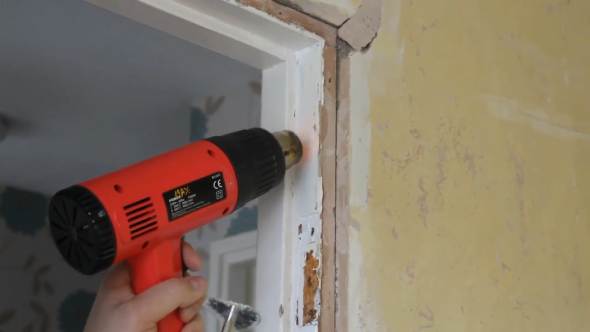
You can remove paint with a hot air gun from wooden door frames using these steps.
Step 1: Apply the Heat to the Wooden Door Frames
Using a heat gun is another effective method for getting paint off wooden door frames. First, make sure that you are wearing protective clothing and safety goggles before beginning the task.
Next, plug in the heat gun, select the desired temperature setting according to your project, and hold it at least four inches away from the surface of the frame.
When heating up the wood, be sure to work in small areas at a time so that you don’t scorch or damage any part of it. Move around in small circles over each area until you start to see blisters forming on the paint’s surface.
Step 2: Scrape the Loosen Paint
Once heated up, use a plastic scraper tool (such as a putty knife) to carefully scrape away loose paint from wooden door frames. Start gently but firmly near the edges and corners of doors where the paint has been softened by the heat.
Scraping too hard could cause damage to underlying woodwork or even splintering if not careful. Make sure to keep your scraper angled at about 45 degrees relative to wood surfaces for optimal results.
This will help ensure you remove all layers without damaging anything underneath or pushing paint into crevices, where it can become harder to remove later on.
Method 4: Use Lacquer Thinner
Lacquer thinner can be used to strip paint from wood as well. Follow these steps for a successful paint-stripping job.
Step 1: Apply the Lacquer Thinner to the Wooden Door Frames
Before applying lacquer thinner to wooden door frames, it is important to wear protective gear and make sure that any flammable objects such as candles, lighter fluid, and matches are removed from the area.
Use a clean paper towel or rag and soak it in lacquer thinner. Be careful handling lacquer thinner since it’s combustible and toxic.
Tape the soaked paper towel into all of the wooden door frames. Make sure that the soaked paper towel covers all of the areas where you want to remove paint from.
Step 2: Wait for an Hour
Once you have applied the lacquer thinner to all of the internal door frames, let it sit for an hour so that it can effectively break down and soften up any of the existing paint on the wood surface.
During this time, make sure that there is plenty of ventilation in the area due to fumes from lacquer thinner being present. If needed, open a window or turn on a fan to increase airflow throughout the room.
It is also important not to leave any flammable items such as cigarettes or matches near while waiting this period as they may ignite with contact with fumes from lacquer thinner.
Step 3: Scrape the Paint
After waiting an hour for lacquer thinner to loosen up the existing paint on your wood door frames, use a plastic scraper or spatula to scrape away any remaining lead paint on them.
Take extra caution when using this utensil due to its sharp edge, which could easily damage your wood surface if not used properly.
With each stroke, be sure not to push too hard against your wood surface, as doing so can cause unnecessary scratches and dents in your wooden door frame.
Be mindful of how much pressure you are applying with each stroke. Too much will cause more damage than necessary, while too little won’t remove enough paint from your wood surface effectively enough.
After you remove all of the paint from your wooden door frames, use a damp cloth or sponge to clean up any residue that is left behind.
This residue is from the lacquer thinner and paint chips that were generated when you scraped off the paint with a spatula or plastic paint scraper tool.
Method 5: Use Pressure Washer
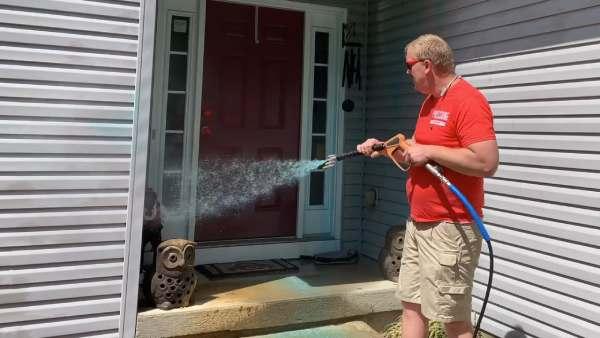
Pressure washing is a great way to spruce up wooden door frames. For best results, be sure to suit up in your protective gear, goggles and gloves before getting started. Follow this simple guide for stripped-down paint removal:
Step 1: Set the Pressure Washer in the Right Pressure Setting
It is important to select the right pressure setting when using a pressure washer for the removal of paint from wooden doors.
The ideal pressure setting for this task should be between 2,500 and 3,000 psi. This is because lower pressures may not be effective in removing the paint, while too much higher pressures can cause damage to the wood surface.
Also, adjusting the nozzle angle and distance from the surface are also factors that need to be taken into consideration when setting up the pressure washer.
The nozzle should be angled slightly downward towards the surface of the door frame and kept at a distance of around 12 inches away from it in order to get maximum efficiency out of the device.
Step 2: Scrape Off the Loose Paint
After loosening up or softening the paint with a pressure washer, it needs to be scraped off with a plastic scraper before attempting any other form of removal method.
This is necessary as it helps ensure that all loose particles have been removed before moving on to further steps.
Plastic scrapers are preferred over metal ones since they are less likely to cause further damage or scratching on wood surfaces which can make future finishing difficult.
Also, when scraping off the paint with a plastic scraper, it is important to use firm but gentle strokes in order to avoid damaging underlying layers of wood which could lead to more problems down the line.
What’s the Right Temperature for Removing Paint From Wood Door Frames Using a Heat Gun?
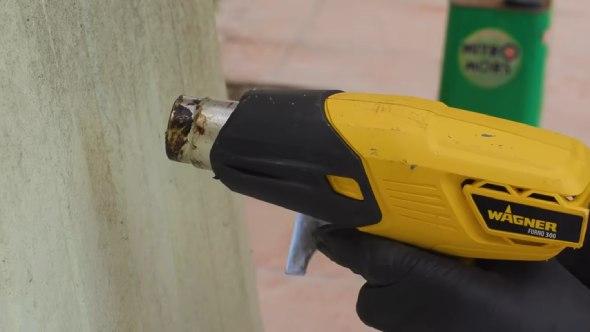
When using a heat gun to strip paint off wooden door frames, the ideal temperature is between 450-500 degrees Fahrenheit.
If you exceed this temperature, it can potentially cause burning or charring of the wood, which could result in irreversible damage.
When using a heat gun, make sure that you are gradually heating up the area and monitoring the paint closely for signs that it is ready to come off, such as bubbling or peeling, before attempting any scraping or other removal methods.
Always wear protective gear like gloves and eyewear when using any kind of heat gun on wood surfaces to protect yourself from burns or splinters.
Does Vinegar Remove Paint from Wooden Doors?
The answer to this question is both yes and no. While vinegar cannot actually take off paint from wooden door frames, it can soften the paint, making it easier to scrape away with a scrubbing brush.
This means that if you are looking for a less labor-intensive way to remove paint from wood furniture, vinegar can be an effective solution.
What Kind of Vinegar Removes Paint from Wooden Door Frames?
White vinegar is typically most effective when you want to strip paint from wooden doors. It has mild acidic properties, which help break down and dissolve paints without damaging or discoloring the furniture beneath.
To use white vinegar for this purpose, mix equal parts white vinegar and water together in a container, then apply directly onto the painted surface with a sponge or cloth and leave on for several minutes before scrubbing away with a scrubbing brush.
Depending on the type of paint used and its age, this method may not always be enough to remove all of the paint completely.
If some areas remain after attempting this method, then additional steps such as sanding or using a chemical stripper may have to be taken to get rid of all traces of the old coat of paint.
Does Hydrogen Peroxide Peel Away Paint from Wooden Doors?
Hydrogen peroxide can be used to effectively eliminate the paint from wooden door frames as well. Hydrogen peroxide works by reacting with and breaking down the chemical bonds within the paint molecules, causing them to flake away.
To use hydrogen peroxide for paint removal, dampen a cloth or scrubber with the substance and cover the painted area with it. Leave it on for 10-15 minutes before gently scrubbing off any loose particles from the surface of your woodwork.
It is important to wear gloves when handling hydrogen peroxide as it can cause skin irritation, and you should ensure that your work area is well-ventilated if you are indoors, as hydrogen peroxide releases harmful fumes when exposed to air.
Can You Use Metal Scrapers to Take Paint Off Wooden Door Frames?
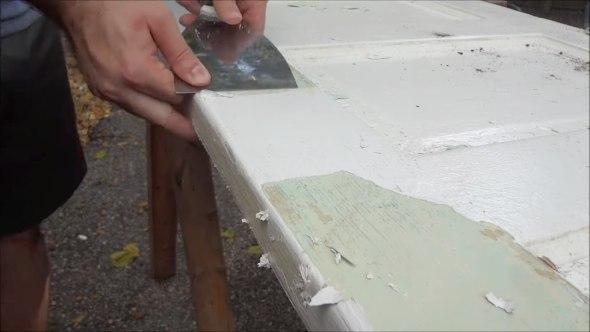
Using a metal scraper to get paint off wooden doors is generally not recommended due to the potential for damaging or scratching the wood surface.
Metal scrapers have hard edges, which can cause abrasions on delicate wood surfaces, making them difficult to refinish afterward.
Aside from that, using metal scraping tools could potentially gouge out chunks of wood from your door frame if used incorrectly or with too much pressure.
If necessary, using a plastic scraper with a dull edge might be an option instead. Only minimal pressure should be used when doing so to avoid any potential damage.
Conquer Paint Removal with Confidence on Your Wood Doors
Removing old paint from wooden door frames can be a hassle, but it’s possible to do with ease when you have the right tools and know-how.
By following our guide above, you will have all the information you need to get rid of unwanted paint without causing extra damage.
Sanding, lacquer thinner, or pressure washers, whatever approach you choose, now you have everything you need to finish the job in no time. Arm yourself with confidence by understanding exactly what each method is capable of so go ahead and pick your preferred technique.

